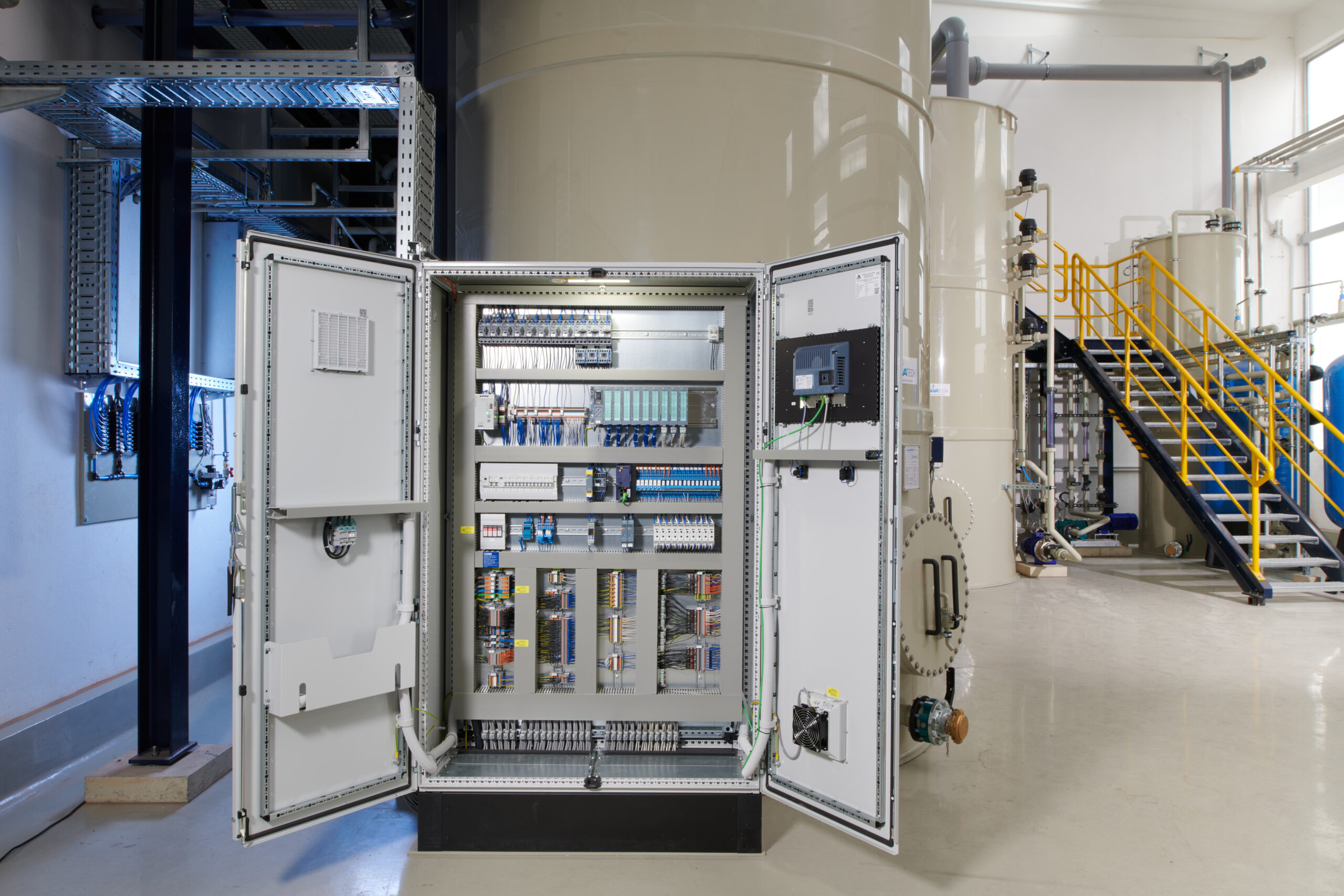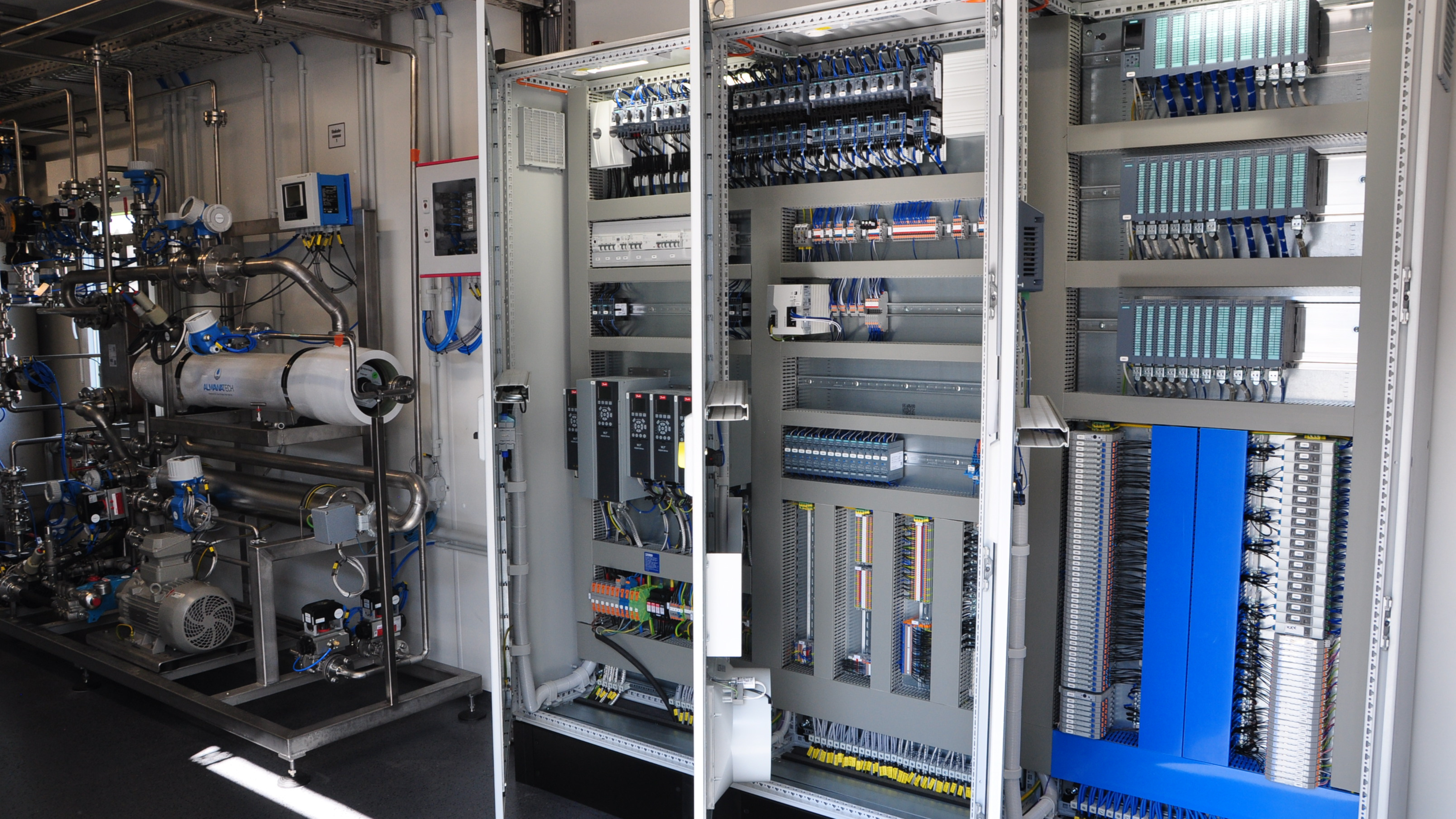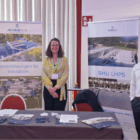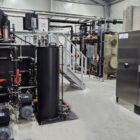The PLC (programmable logic controller) is a central component of automation technology and plays a crucial role in industrial water and wastewater treatment. It enables the control, monitoring and regulation of processes through the processing of input signals, the execution of programmable control logic and the output of control signals. In practice, the PLC is used in almost all water technology systems to make processes safe, efficient and flexible.
Table of contents
Basics of the PLC
The PLC is an electronic device that is capable of performing complex control and regulation tasks. It replaces conventional wiring logic, as previously implemented with relays and contactors, and offers significantly more flexibility and customization options. A PLC typically consists of the following components:
Hardware components
- Central processing unit (CPU): The CPU is the "brain" of the PLC and executes the control program. It processes input and output signals and controls the processes in the system.
- Input modules: These record signals from sensors such as pressure, temperature, flow or level sensors.
- Output modules: They control actuators such as pumps, valves or dosing systems.
- Communication modules: Used for data transmission to other control systems, control systems (SCADA/PLS) or the cloud.
- Memory: Integrated memory stores the control program and process data.
Software and programming
The PLC is programmed using special development environments that implement the logic and control instructions in the CPU. Common programming languages include those standardized according to IEC 61131-3:
- IL (instruction list): A text-based language, suitable for simple control tasks.
- KOP (ladder diagram): A graphical language based on classic wiring logic.
- FBD (function block diagram): Graphical representations for complex logical links.
- ST (Structured Text): A high-level language that is particularly suitable for mathematical calculations and sophisticated algorithms.
- AS (sequence language): Ideal for mapping sequential processes, such as step chain controls.

Photo: Our switchgear with ALMA Controle software developed in-house - system technology, control cabinet planning & programming - everything from a single source (process: CP system ALMA CHEM MCW)
Application areas of the control unit in water and wastewater technology
In water and wastewater treatment, control technology solutions are of central importance in order to operate the complex and often highly variable processes safely and efficiently. The control system takes on the central task of linking all system components with each other and ensuring smooth communication between sensors, actuators and process control systems. The use of programmable logic controllers (PLCs) enables flexible, precise and reliable automation of the systems.
PLC-based control systems
Programmable logic controllers (PLCs) are at the heart of modern automation technology and have become indispensable in water and wastewater technology. They perform tasks such as
- Control of operating processes: From the dosing of chemicals to the control of pumps and valves.
- Safety monitoring: Detection of limit value violations and initiation of emergency measures.
- System monitoring and optimization: Acquisition and processing of measurement data to analyze operating conditions and optimize processes.
Integrating the control system into process control systems such as SCADA makes it possible to monitor, control and document the entire system centrally.
Holistic approach: system planning, control cabinet construction and programming
A particularly great advantage in the implementation of control solutions in water and wastewater technology lies in the combination of system design, control cabinet planning and PLC programming. Close integration of these areas ensures optimum interaction between the systems, which eliminates frequent sources of error such as communication problems at interfaces.
Our strengths in interaction:
- System design: Automation is integrated into the overall concept as early as the planning stage of the system processes.
- Control cabinet construction: The precise planning and construction of the control cabinets takes into account all the requirements of the PLC and the sensors/actuators.
- Programming: The programming of the PLC is specially adapted to the individual requirements of the system and designed for smooth communication.
This holistic approach results in an error-free, well-coordinated control solution that not only works efficiently, but is also easy to maintain and scalable.
PLC manufacturers and programming languages
The market-leading suppliers of PLC systems provide reliable and flexible control solutions that have been specially developed for industrial applications. The most important manufacturers include:
Siemens
With its SIMATIC S7 series and TIA Portal programming software, Siemens is one of the leading suppliers of PLC systems. The platform enables intuitive programming and offers comprehensive functions for process automation. Siemens solutions are particularly popular in large systems and complex applications.
Beckhoff Automation
With its CX controllers and TwinCAT software, Beckhoff offers flexible and PC-based automation solutions. The high degree of openness and scalability make Beckhoff particularly interesting for systems that require individual adaptations.
Rockwell Automation (Allen-Bradley)
With the ControlLogix and CompactLogix systems, Rockwell Automation offers robust PLC solutions that are primarily used in international applications and the process industry. Programming is carried out using the powerful Studio 5000 software.
Schneider Electric
The Modicon series from Schneider Electric in combination with the EcoStruxure Control Expert software is specially designed for energy-efficient control solutions. Schneider PLC systems are often used in medium-sized water and wastewater plants.
WAGO
With its 750 and 760 PLC systems, WAGO offers a particularly compact and modular solution that is suitable for small and medium-sized systems. The open architecture and support of protocols such as Modbus, BACnet or OPC UA enable easy integration into existing systems. Programming is carried out using the e!COCKPIT software or on the basis of CODESYS, which allows flexible adaptation to different application requirements.
ABB
With its AC500 series, ABB supplies state-of-the-art PLC solutions that are characterized by their robustness and flexibility. ABB's PLC systems are particularly suitable for use in demanding industrial environments. They are programmed using Automation Builder, a powerful platform that offers comprehensive functions for process automation, energy monitoring and integration.

Photo: Our switchgear with ALMA Controle software developed in-house - system technology, control cabinet planning & programming - everything from a single source (process: ALMA OSMO reverse osmosis system)
Integration of control in process control systems
The integration of control systems into process control systems (PCS) or SCADA systems (Supervisory Control and Data Acquisition) is a decisive step towards mastering the complexity of modern water and wastewater plants. This integration enables centralized monitoring and control of all plant components, promotes transparency of operating states and optimizes the efficiency and safety of plant operation.
Functions and advantages of process control systems
1. visualization
One of the biggest advantages of a DCS or SCADA system is the ability to graphically display control sequences and system statuses in real time.
- Interactive process images: All relevant data, such as fill levels, pressures, temperatures, pH values or flow rates, are displayed in clear graphics. Operators can react quickly to deviations.
- Alarm messages: Critical states are highlighted in color and alarms provide real-time information about potential faults. This makes it easier to diagnose faults and speeds up troubleshooting.
- Simulations: Many DCSs allow simulations to be carried out to test processes before they are put into practice.
2. data logging
The recording and storage of process data in a central database is a central component of modern process control systems.
- Historical data analysis: Long-term data such as COD values, flow rates or energy consumption can be evaluated in order to recognize trends and identify potential for optimization.
- Report generation: Automatically generated reports enable transparent documentation of operating statuses and serve as proof to authorities or customers.
- Maintenance planning: By analyzing operating data, maintenance intervals can be planned on the basis of actual load (predictive maintenance), which reduces downtimes.
3. remote control
DCS and SCADA systems make it possible to monitor and control systems remotely via networks, including the Internet.
- Remote access: Operators or service technicians can access the system from any location, carry out diagnostics and adjust control parameters.
- Cost efficiency: Remote access reduces the need for on-site visits and enables a rapid response to faults.
- Security measures: Encrypted connections and user rights management ensure that only authorized persons have access to critical system data and controls.
Technical integration of control system and DCS/SCADA
The PLC and process control system are usually connected via industrial protocols that ensure reliable and standardized data exchange. Frequently used protocols are:
- Modbus (TCP/RTU): Widely used in water and wastewater technology, especially for pump and valve control.
- OPC UA (Unified Architecture): Enables platform-independent communication between control systems and control systems with integrated safety architecture.
- PROFINET/Profibus: Particularly suitable for fast communication within systems, e.g. for real-time control.
Implementation typically takes place via central controllers (e.g. Siemens SIMATIC or ABB AC500), which record all relevant data from sensors and actuators and forward it to the DCS/SCADA system.
Future prospects for PLCs in water technology
The further development of PLC technology is increasingly integrating concepts from digitalization and the Internet of Things (IoT):
- IoT connectivity: PLC systems are connected directly to cloud-based platforms to enable global data analysis and remote monitoring.
- Artificial intelligence (AI): AI algorithms are used to analyze operating data in real time and generate suggestions for process optimization.
- Cyber security: With the increasing networking of control systems, the focus is on security concepts such as encrypted data communication and user rights management.
Conclusion
The PLC is an indispensable tool in industrial water and wastewater technology. It offers a flexible, scalable and reliable solution for controlling, monitoring and optimizing processes. By combining it with modern process control systems and technologies such as IoT or AI, the PLC remains a central building block for the further development of automation in water technology. The targeted use of market-leading PLC systems from manufacturers such as Siemens, Beckhoff, WAGO or ABB makes it possible to implement customized and powerful control solutions for every system.
For further information on our products, please feel free to contact us at any time!








